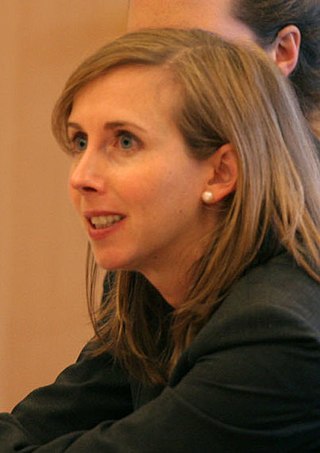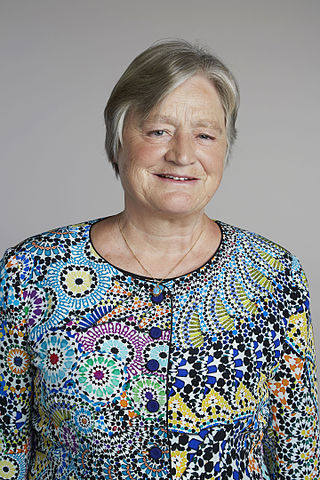Related Research Articles

Meteorology is a branch of the atmospheric sciences with a major focus on weather forecasting. The study of meteorology dates back millennia, though significant progress in meteorology did not begin until the 18th century. The 19th century saw modest progress in the field after weather observation networks were formed across broad regions. Prior attempts at prediction of weather depended on historical data. It was not until after the elucidation of the laws of physics, and more particularly in the latter half of the 20th century, the development of the computer that significant breakthroughs in weather forecasting were achieved. An important branch of weather forecasting is marine weather forecasting as it relates to maritime and coastal safety, in which weather effects also include atmospheric interactions with large bodies of water.

An urban heat island (UHI) is an urban area that is significantly warmer than its surrounding rural areas due to human activities. The temperature difference is usually larger at night than during the day, and is most apparent when winds are weak. UHI is most noticeable during the summer and winter. The main cause of the UHI effect is from the modification of land surfaces. A study has shown that heat islands can be affected by proximity to different types of land cover, so that proximity to barren land causes urban land to become hotter and proximity to vegetation makes it cooler. Waste heat generated by energy usage is a secondary contributor. As a population center grows, it tends to expand its area and increase its average temperature. The term heat island is also used; the term can be used to refer to any area that is relatively hotter than the surrounding, but generally refers to human-disturbed areas.

A weather station is a facility, either on land or sea, with instruments and equipment for measuring atmospheric conditions to provide information for weather forecasts and to study the weather and climate. The measurements taken include temperature, atmospheric pressure, humidity, wind speed, wind direction, and precipitation amounts. Wind measurements are taken with as few other obstructions as possible, while temperature and humidity measurements are kept free from direct solar radiation, or insolation. Manual observations are taken at least once daily, while automated measurements are taken at least once an hour. Weather conditions out at sea are taken by ships and buoys, which measure slightly different meteorological quantities such as sea surface temperature (SST), wave height, and wave period. Drifting weather buoys outnumber their moored versions by a significant amount.

Ice crystals are solid ice in symmetrical shapes including hexagonal columns, hexagonal plates, and dendritic crystals. Ice crystals are responsible for various atmospheric optic displays and cloud formations.

The Meteorological Office, abbreviated as the Met Office, is the United Kingdom's national weather service. It is an executive agency and trading fund of the Department for Science, Innovation and Technology and is led by CEO Penelope Endersby, who took on the role as Chief Executive in December 2018 and is the first woman to do so. The Met Office makes meteorological predictions across all timescales from weather forecasts to climate change.

The natural environment or natural world encompasses all living and non-living things occurring naturally, meaning in this case not artificial. The term is most often applied to Earth or some parts of Earth. This environment encompasses the interaction of all living species, climate, weather and natural resources that affect human survival and economic activity. The concept of the natural environment can be distinguished as components:

The Bartlett Faculty of the Built Environment, also known as The Bartlett, is the academic centre for the study of the built environment at University College London (UCL), United Kingdom. It is home to thirteen departments that have expertise in individual subfields, including the Bartlett School of Architecture, Bartlett School of Planning, Bartlett Development Planning Unit, and the Centre for Advanced Spatial Analysis. The Bartlett is consistently ranked the highest in Europe and the UK and among the highest in the world for the "Architecture and the Built Environment" category in major rankings. It is currently ranked the first in the world for the year 2023.

Numerical weather prediction (NWP) uses mathematical models of the atmosphere and oceans to predict the weather based on current weather conditions. Though first attempted in the 1920s, it was not until the advent of computer simulation in the 1950s that numerical weather predictions produced realistic results. A number of global and regional forecast models are run in different countries worldwide, using current weather observations relayed from radiosondes, weather satellites and other observing systems as inputs.

The Royal Netherlands Meteorological Institute is the Dutch national weather forecasting service, which has its headquarters in De Bilt, in the province of Utrecht, central Netherlands.

In atmospheric science, an atmospheric model is a mathematical model constructed around the full set of primitive, dynamical equations which govern atmospheric motions. It can supplement these equations with parameterizations for turbulent diffusion, radiation, moist processes, heat exchange, soil, vegetation, surface water, the kinematic effects of terrain, and convection. Most atmospheric models are numerical, i.e. they discretize equations of motion. They can predict microscale phenomena such as tornadoes and boundary layer eddies, sub-microscale turbulent flow over buildings, as well as synoptic and global flows. The horizontal domain of a model is either global, covering the entire Earth, or regional (limited-area), covering only part of the Earth. The different types of models run are thermotropic, barotropic, hydrostatic, and nonhydrostatic. Some of the model types make assumptions about the atmosphere which lengthens the time steps used and increases computational speed.

Heidi M. Cullen is the Director of Communications and Strategic Initiatives at MBARI, the Monterey Bay Aquarium Research Institute. Cullen was previously the chief scientist for the non-profit environmental organization, Climate Central, located in Princeton, New Jersey. In addition, she is a guest lecturer at nearby Princeton University, and the author of the book, The Weather of the Future. An expert and commentator about issues related to climate change and the environment, she was an on-air personality at The Weather Channel, and is a senior research fellow at the University of Pennsylvania (Penn).

A tropical cyclone is a rapidly rotating storm system characterized by a low-pressure center, a closed low-level atmospheric circulation, strong winds, and a spiral arrangement of thunderstorms that produce heavy rain and squalls. Depending on its location and strength, a tropical cyclone is referred to by different names, including hurricane, typhoon, tropical storm, cyclonic storm, tropical depression, or simply cyclone. A hurricane is a strong tropical cyclone that occurs in the Atlantic Ocean or northeastern Pacific Ocean, and a typhoon occurs in the northwestern Pacific Ocean. In the Indian Ocean and South Pacific, comparable storms are referred to as "tropical cyclones", and such storms in the Indian Ocean can also be called "severe cyclonic storms".

In meteorology and climatology, a mesonet, portmanteau of mesoscale network, is a network of automated weather and, often also including environmental monitoring stations, designed to observe mesoscale meteorological phenomena and/or microclimates.

The history of numerical weather prediction considers how current weather conditions as input into mathematical models of the atmosphere and oceans to predict the weather and future sea state has changed over the years. Though first attempted manually in the 1920s, it was not until the advent of the computer and computer simulation that computation time was reduced to less than the forecast period itself. ENIAC was used to create the first forecasts via computer in 1950, and over the years more powerful computers have been used to increase the size of initial datasets as well as include more complicated versions of the equations of motion. The development of global forecasting models led to the first climate models. The development of limited area (regional) models facilitated advances in forecasting the tracks of tropical cyclone as well as air quality in the 1970s and 1980s.

Julia Mary Slingo is a British meteorologist and climate scientist. She was Chief Scientist at the Met Office from 2009 until 2016. She is also a visiting professor in the Department of Meteorology at the University of Reading, where she held, prior to appointment to the Met Office, the positions of Director of Climate Research in the Natural Environment Research Council (NERC) National Centre for Atmospheric Science and founding director of the Walker Institute for Climate System Research.

The contributions of women in climate change have received increasing attention in the early 21st century. Feedback from women and the issues faced by women have been described as "imperative" by the United Nations and "critical" by the Population Reference Bureau. A report by the World Health Organization concluded that incorporating gender-based analysis would "provide more effective climate change mitigation and adaptation."
The desert-covered Kingdom of Saudi Arabia is the geographically largest country in the Middle East. Moreover, it accounts for 65% of the overall population of the GCC countries and 42% of its GDP. Saudi Arabia does not have a strong history in environmentalism. Thus, as the number of population increases and the industrial activity grows, environmental issues pose a real challenge to the country.
Christine Susan Betham Grimmond is a New Zealand scientist and professor of urban meteorology at the University of Reading. She currently holds the post of Met Office Joint Chair. Grimmond is a pioneer of the fields of urban meteorology and micrometerology, which deal with the atmospheric boundary layer.
Emily Black is a British environmental scientist. As of June 2022, she is Professor of Meteorology at the University of Reading and a senior research fellow in National Centre for Atmospheric Science (Climate).
References
- 1 2 "University of Reading | Janet Barlow".
- ↑ Ravilious, Kate (2015-02-23). "Kate Ravilious on research looking at ways to improve our indoor weather". The Guardian. ISSN 0261-3077 . Retrieved 2019-11-01.
- ↑ "Janet Barlow CV" (PDF).
- ↑ "Dept of Meteorology - University of Reading". www.met.rdg.ac.uk. Retrieved 2019-11-01.
- ↑ "Technologies for Sustainable Built Environments -". Technologies for Sustainable Built Environments. Retrieved 2019-11-01.
- ↑ "About". www.refresh-project.org.uk. Retrieved 2019-11-01.
- ↑ "Janet F. Barlow - Google Scholar Citations". scholar.google.co.uk. Retrieved 2019-11-01.
- ↑ Barlow, Janet F.; Shao, Li; Smith, Stefan Thor (2018), "Climate Change, Resilience and the Built Environment", Sustainable Futures in the Built Environment to 2050, John Wiley & Sons, Ltd, pp. 25–49, doi:10.1002/9781119063834.ch2, ISBN 9781119063834
- ↑ "Atmospheric Science for Environmental Scientists, 2nd Edition | Wiley". Wiley.com. Retrieved 2019-11-01.
- ↑ "Oases of cool: Taking the heat out of urban living". www.newscientist.com. Retrieved 2019-11-01.
- ↑ "The Team » ACTUAL Project" . Retrieved 2019-11-01.
- ↑ "BBC Two - Horizon, 2010-2011, What is One Degree?". BBC. Retrieved 2019-11-01.
- ↑ "People @ ClearfLo Project" . Retrieved 2019-11-01.
- ↑ Shukman, David (2012-08-08). "Effort set to track air pollution" . Retrieved 2019-11-01.
- ↑ "BBC One - Wild Weather, Climate in the City". BBC. Retrieved 2019-11-01.
- ↑ Reading meteorologists help keep the lights on , retrieved 2019-11-01
- ↑ UCL (2016-11-30). "UCL-Energy Seminar: 'Measuring and modelling urban microclimate,' Professor Janet Barlow, University of Reading". UCL Energy Institute. Retrieved 2019-11-01.
- ↑ "Past Board Members | International Association for Urban Climate" . Retrieved 2019-11-01.